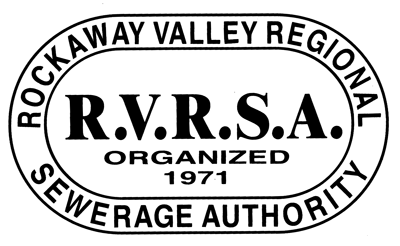Facility Overview
Process Description
RVRSA WASTEWATER TREATMENT PLANT
The RVRSA is an “activated sludge” treatment facility, consisting of several major structures, including: preliminary treatment building, oxidation channels, control building, division boxes, final clarifiers, chlorination channels, chemical building, sludge thickening building and other structures not related to the direct operations of the treatment plant.
The following is a description of each major structure at the treatment plant.
Preliminary Treatment Building
The Preliminary Treatment Building or PT Building is where all the wastewater (influent) enters the facility. The PT building consists of four (4) raw wastewater channels with bar racks/screens (3 equipped with mechanical bar screens and 1 equipped with a manual bar rack), which removes rags and large inorganic/organic material from the incoming raw wastewater. Screened raw wastewater next enters an aerated grit chamber where the flow is decreased to settle out any grit material (sand, grit, egg shells). It is important to remove such material (rags & girt) material from the wastewater to avoid potential operational problems with pumps or other mechanical equipment located in the plant.
The rags, screenings and grit are removed and disposed of off-site.
Division Box A
Next flow enters “Division Box A”, which is equipped with a series of slide gates that allow for the total flow from the PT Building to be distributed (at a predetermined rate) to the Oxidation Channels. Sodium Hypochlorite (more commonly known as Chlorine or bleach) can be fed to this flow to control odors.
Oxidation Channels
After passing through Division Box A, the flow is diverted to the oxidation channels. The RVRSA has four (4) oxidation channels, situated in pairs on the north and south sides of the control building. Each oxidation channels is 2.75 mgd; 300’ (long) x 100’ (wide) x 12’ (side) water depth. It is at this location where the secondary treatment occurs. Microorganisms (certain bacteria or “bugs”) breakdown organic wastes that are found in the wastewater. The flow is also “aerated” to supply oxygen to the microorganisms to optimize the breakdown of the material. Each channel has four (4) sets of rotors which supply the oxygen to the flow. These rotors are also controlled by Variable Frequency Drives (VFDs), which allows for more precise control of the aeration of the activated sludge (which allows for biological reduction of phosphorus and enhanced de-nitrification).
Division Box B
At Division Box B, all the flow that is leaving the oxidation channels enters here. Division Box B is responsible for distributing the flow to the four (4) separate final clarifiers. Just as at Division Box A, Division Box B has a series of slide gates that allow the operator to direct the flow to the appropriate clarifier (1 – 4). More importantly, the flow rate to each clarifier can be changed by adjusting the height of the weir feeding the flow to any specific clarifier. Let it also be noted that Division Box B is also equipped with aeration equipment which supplies air (from blowers) located in the basement of the Control Building.
Final Clarifiers
Flow next enters one of four (4), 100 foot, square clarifiers, which are equipped with circular sludge removal mechanisms. Here “sludge” is settled out to the bottom of the clarifiers via gravity. The sludge is then either pumped back to the oxidation channel (as Return Activated Sludge — or RAS) or is sent to the sludge thickening building (as Waste Activated Sludge — or WAS). Partially treated effluent can be seen flowing over weirs, as clear water, and onto the next stage, which is chlorination.
Disinfection, De-Chlorination and Final Discharge
Flow next enters the disinfection system, which consists of three (3) Sodium Hypochlorite tanks and pumping, and monitoring equipment. RVRSA currently uses “liquid” sodium hypochlorite for disinfection. Prior to entering the final “discharge” location, the flow is de-chlorinated, using liquid sodium bisulfate. These chemicals are fed into the system, using operating equipment, which is found in the “Chemical Building.” The chemical building consists of three (3) rooms: the service water pump room, sodium hypochlorite feed room, and the sodium bisulfate feed room.
After chlorination, the now “treated” wastewater — or effluent — flows into the Rockaway River.
Daily sampling and testing is conducted to the Influent and Effluent of the RVRSA facility to insure RVRSA is meeting and complying with its NJPDES permit.
Control Building
The Control Building houses a portion of the mechanical and electrical equipment used to run the operations of the plant. It also houses the administrative offices and RVRSA’s on-site New Jersey certified laboratory.
The standby generator for the RVRSA plant is also located here. This supplies electricity to the entire plant in the event that facility looses utility power.
Also, a majority of the process pumping equipment is located in the basement of the control building. Six (6) return activated sludge (RAS) and two (2) waste activated sludge (WAS) pumps, along with process air blowers, are located here.
Sludge Thickening Building
The Sludge Thickening Building houses the equipment that processes the sludge collected in and removed from the final clarifiers. The equipment located at this building includes: a waste sludge holding tank (formerly gravity thickening tank), three (3) rotating drum thickeners (RDT’s), sludge holding tanks and other supporting process equipment. The facility produces a thickened sludge ranging between 5 – 6% solids concentration. The sludge is then loaded into a tanker truck and is hauled off-site to Passaic Valley Sewerage Commission located in Newark, New Jersey, for further treatment and ultimate disposal.
